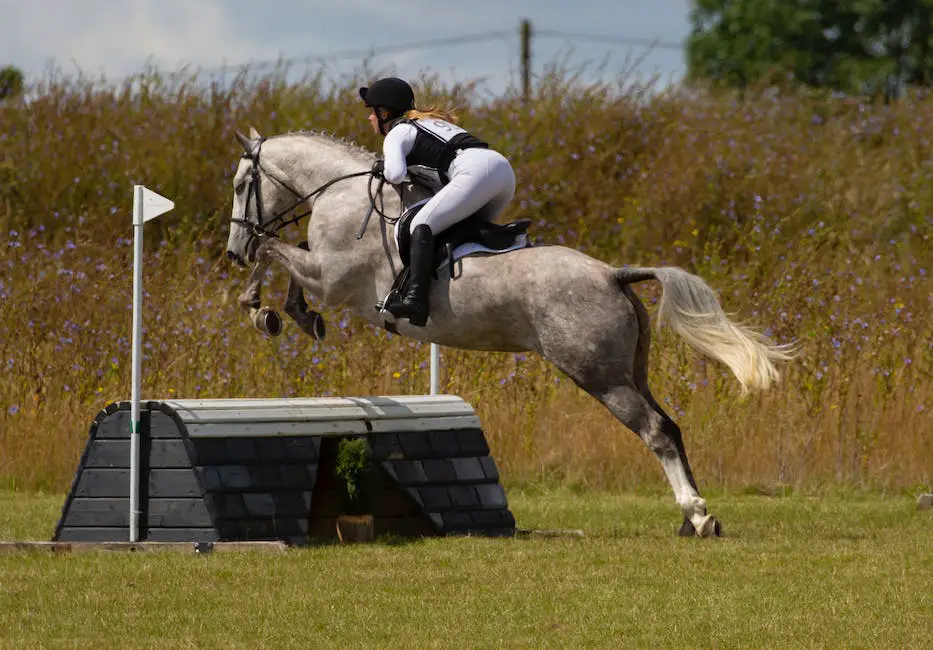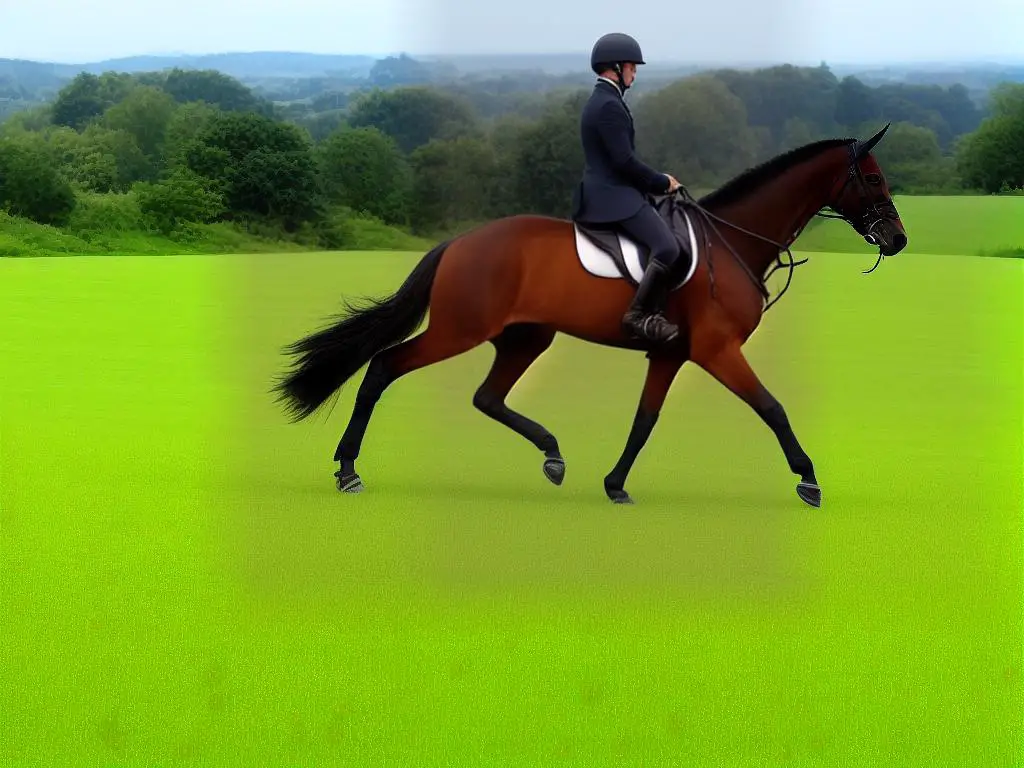German warmblood horses have been captivating equestrians and horse enthusiasts with their exceptional athleticism, elegant appearance, and versatile performance capabilities. These horses have a rich history and breeding practices that render them ideal for various competitive disciplines such as dressage, show jumping, and eventing. In this article, we will delve deeper into the world of German warmblood performance horses by exploring their history, breeding, disciplines, training and care, and finally, the buying and selling process of these remarkable equine athletes.
Table of Contents (Horspedia)
History and Breeding
German Warmblood Horses
German Warmblood horses have a rich history and are known for their exceptional performance in various equestrian disciplines such as dressage, show jumping, and eventing. The origin of these horses dates back to the early-19th century, with their development taking place throughout several regions of Germany. Breeding practices for these horses have focused on enhancing specific traits that are desirable for competition, resulting in a versatile and athletic breed. Various registries and organizations govern the breeding and classification of German Warmbloods, ensuring that only the finest specimens are produced and recognized.
History of German Warmbloods
The development of the German Warmblood can be traced back to the early 1800s when various local horse breeds were used to produce a robust and versatile workhorse. These early warmbloods were commonly used for agricultural purposes and general transportation. Throughout the 20th century, the focus shifted towards breeding for sport and performance, resulting in the modern German Warmblood we recognize today.
Several distinctive regional varieties of German Warmbloods exist, each with its unique characteristics and origins. Some of the most well-known varieties include the Hanoverian, Holsteiner, Oldenburg, and Westphalian. These regional types were developed by crossbreeding local German horses with imported breeds such as Thoroughbreds, Arabians, and Anglo-Arabians to improve athletic ability and performance for equestrian sports.
Breeding Practices
Selective breeding practices have played a crucial role in the development of the German Warmblood as a performance horse. Breeders have focused on enhancing traits such as temperament, conformation, athleticism, and movement to create a horse that is ideally suited for equestrian competition.
One of the significant aspects of German Warmblood breeding is the rigorous selection process for stallions and mares used for breeding. Stallions must pass a series of performance tests and evaluations in order to be approved for breeding. Mares are also assessed for their conformation, movement, and performance, with only those meeting high standards being selected.
As a result of these stringent breeding practices, German Warmbloods display a consistent type that is athletic, well-balanced, and visually appealing. These horses have strong, well-proportioned bodies, with refined yet powerful muscle structure. They exhibit excellent movement with light, elastic gaits and are known for their remarkable jumping ability. Additionally, German Warmbloods are appreciated for their intelligent and trainable temperament, making them suitable for both amateur and professional riders.
Registries and Organizations
To ensure the performance quality and the preservation of each German Warmblood regional type, several registries and organizations have been established. These organizations set breeding standards and organize evaluations for both stallions and mares. They also oversee registration, inspection, and classification of German Warmblood horses to verify their lineage and maintain breed integrity.
Some of the most recognized German Warmblood registries include the Hanoverian Society, the Holsteiner Verband, the Oldenburg Horse Breeders’ Society, and the Westphalian Horse Studbook. These registries not only maintain breeding records and promote their regional varieties, but they also support the development and improvement of German Warmblood performance through various breeding programs and initiatives.
Introduction
German Warmbloods have long been revered for their outstanding performance in the world of equestrian sports, thanks to a carefully crafted breeding program and strict adherence to regulations set forth by various registries. These versatile horses possess a unique blend of agility, strength, and willingness to perform, making them highly sought after by equestrians around the globe. This article seeks to explore the history and breeding practices that have led to the development of exceptional German Warmbloods, as well as the notable achievements and disciplines in which they excel.

Disciplines and Competitions
German Warmbloods in Equestrian Disciplines and Competitions
As a result of their carefully honed pedigree and impressive performance capabilities, German Warmbloods have become a dominant force in the world of equestrianism. Their prowess can be observed across a variety of disciplines, including dressage, show jumping, and eventing, at both national and international levels. This section of the article will delve into the specific disciplines and competitions where German Warmbloods shine, highlighting the accomplishments of some noteworthy horses and riders who have made their mark in these respective fields.
Dressage
Dressage is an equestrian discipline that emphasizes the harmonious partnership between horse and rider, with the horse demonstrating exceptional levels of obedience, suppleness, and balance.
German warmblood horses, such as the Hanoverian, Oldenburg, and Westphalian breeds, have consistently demonstrated their competitive edge in dressage competitions around the world.
One notable example of a successful German warmblood dressage horse is the Hanoverian mare, Salinero. Ridden by Dutch rider Anky van Grunsven, Salinero has amassed an impressive array of titles in international competition, including two Olympic gold medals and three World Equestrian Games gold medals.
Show Jumping
Show jumping is another discipline where German warmblood horses have demonstrated their prowess. In this discipline, the horse and rider must navigate a course of jumps, showcasing their agility, precision, and power.
German breeds such as the Holsteiner, Rhenish, and Württemberger have excelled in show jumping competitions worldwide, with many top-ranking show jumpers opting for German warmbloods as their mounts of choice.
One standout example is the Holsteiner gelding, Shutterfly, who was ridden by German rider Meredith Michaels-Beerbaum. Together, they secured numerous championship titles, including three World Cup Finals victories and several European Championship medals.
Eventing
Eventing is a three-phase equestrian discipline that combines dressage, cross-country, and show jumping elements. This all-around test of horsemanship and athleticism requires versatile and sturdy horses, and German warmbloods fit the bill well.
Breeds such as the Trakehner, Mecklenburg, and Brandenburger have made their mark in the eventing world, with numerous top eventing horses being of German warmblood descent.
One example is the German-bred eventing horse, La Biosthetique-Sam FBW, ridden by German Olympian Michael Jung. This pair has achieved remarkable success, with numerous championship victories, including three consecutive European Championship gold medals and two Olympic gold medals.
Other Equestrian Competitions
In addition to these three primary disciplines, German warmblood horses have also excelled in other equestrian competitions such as combined driving, endurance racing, and even western riding events. Their adaptability and athleticism make them a top choice for equestrians of all levels seeking a horse that can perform at the highest levels in a variety of disciplines.
Conclusion
German Warmblood horses have solidified their reputation as top-performers in various equestrian disciplines and competitions around the globe.
Notable achievements from horses and riders like Anky van Grunsven, Meredith Michaels-Beerbaum, and Michael Jung, serve as a testament to the capabilities of these adaptable and talented equines.
Their ongoing success ensures that German Warmbloods will continue to be a popular and respected choice for equestrians in search of high-performance equine partners.

Training and Care
The German Warmblood
Renowned for their athleticism, versatility, and elegance, the German Warmblood is a highly sought-after breed in the realm of equestrian sports. These horses excel in various disciplines, such as dressage, show jumping, and eventing. To preserve and enhance their exceptional performance abilities, it is essential to employ proper training methods and care practices specific to German Warmbloods.
Training Methods
Effective and consistent training is critical for achieving optimal performance in German Warmbloods. It is crucial to begin with a solid foundation, such as groundwork and in-hand work, before introducing a horse to ridden work. Establishing trust and communication between the horse and rider sets the stage for a successful partnership in any discipline.
Once a horse is ready for ridden work, it is essential to focus on developing a balanced and supple horse. This can be achieved through dressage foundation training, using various exercises to encourage the horse to work through its back and engage its hindquarters. Lateral work, such as leg-yielding, shoulder-in, and haunches-in, can also improve a horse’s agility and balance.
In addition to dressage work, German Warmbloods benefit from training that strengthens their power, jumping ability, and cardiovascular fitness. Incorporating gymnastic exercises and gridwork, as well as trail rides and conditioning work, helps these horses reach their full potential in their chosen discipline.
Consistency and patience are key when training German Warmbloods. A gentle approach is more effective, as these horses are intelligent and sensitive to their handler’s cues. It is essential to set clear expectations and reward the horse for good behavior, leading to a confident and happy athlete.
Nutritional Needs
To support their athleticism, German Warmbloods require a balanced and nutritious diet. High-quality forage, such as hay or pasture, should make up the majority of their diet, providing essential nutrients and maintaining proper digestive function.
As athletes, these horses often require additional calories and nutrients to maintain their weight, muscle mass, and stamina. Concentrates, such as grain or a pelleted feed, can provide the necessary energy for peak performance. However, it is crucial not to overfeed concentrates, as excessive grain intake can lead to health issues.
Supplements can also play a role in meeting a German Warmblood’s nutritional needs, especially during periods of intense training or competition. Electrolytes, joint support, and vitamin and mineral supplements can ensure that the horse has everything it needs to excel.
General Care
Like any horse, German Warmbloods require routine care to maintain their overall health and well-being. Regular grooming not only keeps the horse looking its best but also promotes circulation and allows for early detection of injuries or skin issues.
Daily turnout is essential for these horses, allowing them sufficient time to stretch their legs, graze, and socialize with other horses. Adequate turnout also prevents boredom and behavioral issues related to stall confinement.
Routine veterinary care, including vaccinations, dental work, and deworming, is another essential aspect of caring for a German Warmblood. Regular farrier work, including trimming and shoeing, prevents hoof problems and ensures proper hoof balance.
German Warmblood Horses
German Warmblood horses are well-renowned for their athleticism, versatility, and ability to excel in various equestrian sports. As these horses have gained popularity worldwide, the demand for quality German warmblood horses has increased, making the process of buying and selling these horses a relevant and important topic for prospective horse owners. In order to ensure their peak performance, it is vital for owners and trainers to implement a comprehensive training program, balanced nutrition, and attentive care practices for these exceptional athletes.

Buying and Selling
Achieving Peak Performance
Achieving and maintaining peak performance in German Warmbloods requires commitment to a comprehensive training program, balanced nutrition, and attentive care practices. Through the combination of these elements, these exceptional athletes can thrive in their chosen equestrian disciplines, showcasing their skills and contributing to their popularity. By focusing on these aspects, both established and future German Warmblood owners can ensure their equine athletes achieve their full potential.
What to Look For in a Quality German Warmblood Performance Horse
When searching for a German warmblood performance horse, it’s crucial to examine the animal’s overall conformation, movement, temperament, and athletic ability. A horse with a strong, well-built body and correct conformation will typically possess better athletic capabilities and a lower risk of injury. In addition, a balanced and fluid movement, coupled with a willing and trainable temperament, is highly sought after in a quality performance horse.
It’s important to also consider the horse’s pedigree and bloodlines, as these factors can provide insight into a horse’s potential performance abilities and temperament. Investing in a horse with proven, successful parentage will increase the likelihood of acquiring a talented and successful competition horse.
Finally, the horse’s health and soundness should be thoroughly assessed. Verify the horse’s medical history, and consider conducting a pre-purchase veterinary examination to identify any potential health concerns or issues that could later affect the horse’s performance.
Price Ranges
The prices of German warmblood performance horses can vary greatly, depending on factors such as age, pedigree, training level, and overall quality. Younger, less experienced horses with good pedigrees generally start at around $10,000, while mature, highly trained horses with proven competition records can exceed $100,000. It’s essential to keep in mind that the price of a horse does not always guarantee success; many more affordable horses are hidden gems with the potential for greatness.
Sourcing Reputable Breeders and Sellers
Finding a reputable breeder or seller is an essential part of purchasing a quality German warmblood horse. To begin your search for German warmblood breeders, consider checking listings and advertisements on equestrian websites, social media groups, and online classifieds. Additionally, attending breed-specific events such as shows, competitions, and breed society meetings can introduce you to breeders and sellers in your area.
When evaluating a potential breeder or seller, it’s important to ascertain their reputation within the equestrian community. Seek references from past clients, and ask questions about the horse’s upbringing, training, and care history. A reputable breeder or seller should be able and willing to provide thorough information about the horse, their breeding program, and answer any questions you may have.
Lastly, when purchasing a German warmblood performance horse from another country, it’s essential to be aware of the costs and logistical considerations related to international shipping, quarantine, and import requirements. Working with a knowledgeable and experienced agent can help to facilitate this process smoothly and efficiently.
Conclusion
Investing in a German warmblood performance horse can be a rewarding endeavor, provided you take the time to research and find the right horse to suit your needs and goals. By focusing on finding a horse with a strong conformation, temperament, and pedigree, purchasing from a reputable breeder or seller, and considering the costs of ownership, you can lay the groundwork for a successful and fulfilling partnership with your new equine athlete.

Throughout the years, German warmblood horses have earned their reputation for excellence in a myriad of disciplines and competitions, thanks to their impeccable breeding, versatility, and outstanding performance capabilities. By understanding and appreciating their history, breeding practices, and training methods, we can gain a greater appreciation for these equine athletes. Whether you are a prospective buyer or simply an admirer, the world of German warmblood performance horses is undeniably fascinating and inspiring, showcasing the true potential of harmonious partnership between horse and rider.
